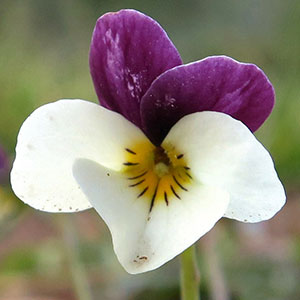Viola hallii
Viola labradorica
Hall's violet, Oregon violet, wild pansy
alpine violet, American dog or Labrador or alpine violet, American dog violet, dog violet, Labrador violet, violette du Labrador
1–3, decumbent or ascending to erect, ca. 1/2 subterranean, glabrous, clustered on single, short, vertical, deep-seated caudex.
1–5, erect (later reclining), glabrous, on caudex from subligneous rhizome.
basal and cauline;
basal: 1–4, palmately compound, ± 2-ternate or 3-ternate, leaflets 3;
stipules adnate to petiole, forming 2 linear-lanceolate wings, unlobed, margins entire, apex of each wing free, acute;
petiole 5–8 cm, glabrous;
blade ovate to deltate, 2.8–6 × 2.6–6.5 cm, ± coriaceous, base tapered, ultimate lobes narrowly elliptic, lanceolate, or oblanceolate, 1–7 mm wide, margins entire, ciliate or eciliate, apex acute, mucronulate, surfaces glabrous;
cauline similar to basal except: stipules usually lanceolate, sometimes broadly ovate, ± leaflike, margins toothed;
petiole 1.3–6 cm;
blade 2–4.8 × 1.2–5.5 cm.
basal and cauline;
basal: 1–5;
stipules mostly lanceolate-linear, margins usually laciniate with gland-tipped projections, apex acute;
petiole 1–9.5 cm, glabrous or puberulent;
blade reniform or ovate to deltate, 1.4–5.5 × 1.8–5.3 cm, base cordate, not decurrent on petiole, margins crenate or serrate, mostly eciliate, apex acute to obtuse, surfaces usually glabrous, sometimes pubescent adaxially near margin;
cauline similar to basal except: stipules lanceolate to ovate, margins ± entire or laciniate, projections often gland-tipped, apex acuminate;
petiole 0.5–3.6 cm, glabrous;
blade narrowly ovate to orbiculate, 1.8–2.9 × 1.5–3.1 cm, base deeply cordate to truncate, margins regularly crenate, apex obtuse to broadly rounded or apiculate.
2.5–11 cm, glabrous.
5–9 cm, glabrous or pubescent.
sepals lanceolate to ovate, margins ciliate, auricles 0.5–1 mm;
petals: upper 2 almost black abaxially, dark reddish violet adaxially, lower 3 pale yellow, cream, or ± white, lateral 2 bearded, with deep yellow to orange patch basally, dark reddish violet-veined, lowest with deep yellow to orange patch basally, dark reddish violet-veined, 5–18 mm, spur yellow, gibbous, 0.5–2 mm;
style head bearded; cleistogamous flowers absent.
sepals lanceolate, margins ciliate or eciliate, auricles not enlarged in fruit, 1–1.5 mm;
petals usually lavender-violet to violet on both surfaces, rarely white, lower 3 white basally, darker violet-veined, lateral 2 sparsely bearded, lowest 9–16 mm, spur white to pinkish violet, elongated, 4–8 mm, tip usually straight, sometimes curved up;
style head beardless; cleistogamous flowers unknown.
ellipsoid, 4–12 mm, glabrous.
ovoid to ellipsoid, 5–7 mm, glabrous.
light brown, shiny, 3.2–3.5 mm.
beige to bronze, 1.5–2 mm.
= 60, 72.
= 20.
Viola hallii
Viola labradorica
Viola hallii was discovered on the grounds of Willamette University in Salem, Oregon, by Elihu Hall, a professor at that institution (V. B. Baird 1942). Leaves of V. hallii are similar to V. beckwithii.
(Discussion copyrighted by Flora of North America; reprinted with permission.)
H. E. Ballard (1994) made a compelling case for including Viola conspersa within V. labradorica, which is followed here. Ballard (1992) did not recognize V. labradorica as occurring in Colorado. Several western herbaria have collections identified as V. labradorica (ASC, CS, KHD, RM, RMBL; http://swbiodiversity.org/seinet/index.pho). Labels on some collections at KHD imply that V. labradorica is considered synonymous with V. adunca var. bellidifolia.
Viola labradorica reportedly hybridizes with V. adunca, V. rostrata (= V. ×malteana House), and V. striata (= V. ×eclipes H. E. Ballard), and less frequently with V. walteri var. appalachiensis and var. walteri.
(Discussion copyrighted by Flora of North America; reprinted with permission.)


